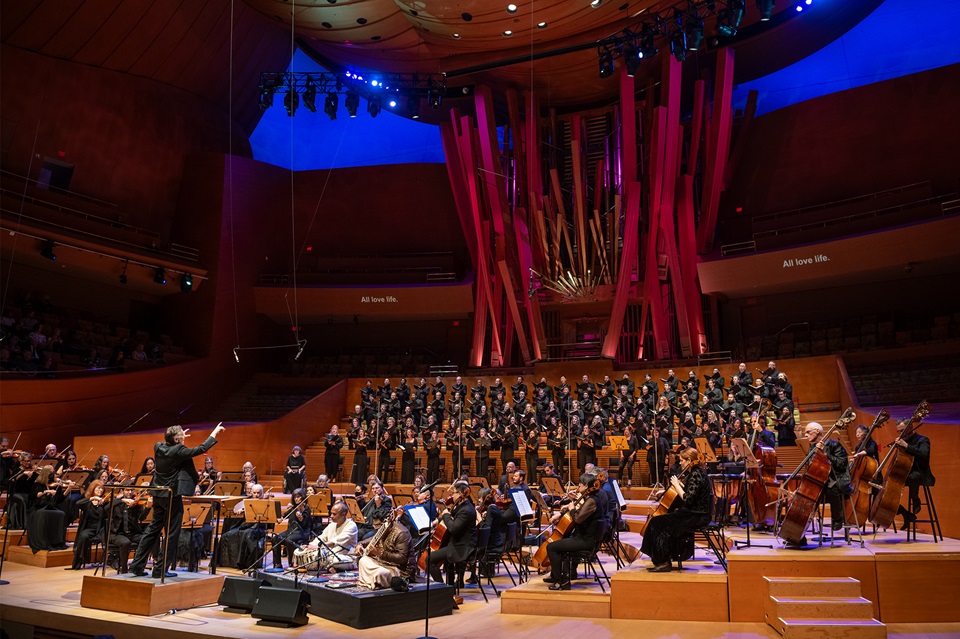
LOS ANGELES (Oct. 15) — Can music move heaven and earth? Many composers over the centuries have tried, and a select few—Bach and Beethoven come to mind—have imposed a lasting imprint on humanity, art that stirs the human soul to action for a higher purpose. Even single songs like “Kevin Barry,” “Joe Hill,” “The Peat Bog Soldiers,” “The People United Will Never Be Defeated” or “The Internationale” have given heart to millions of people in struggle.
Perhaps the more sober question is: Can heaven and earth move music? The answer to that is a definitive yes. Adherence to a spiritual tradition, or a bow to the power of nature and the land, has inspired some of music’s greatest expressions.
We are reminded of such questions when one of the great choruses of the world, the Los Angeles Master Chorale, sets its sights on two modern works of profound spirituality, performed at Walt Disney Concert Hall Sun., Oct. 15. The inclusion of distinguished soloists and a full orchestra to accompany the 101 AGMA union singers made this occasion, titled “Heaven + Earth,” featuring the music of Reena Esmail and Philip Glass, an uplifting and memorable event, with a major choral work by these two living composers as the two halves of the evening. The LAMC Artistic Director Grant Gershon conducted—expertly, as always.
How can I use this voice?
The concert began with Reena Esmail’s (b. 1983) This Love Between Us: Prayers for Unity, which LAMC first sang in 2018 in only its second performance anywhere. That introduction to LAMC later led to her being engaged as the Swan Family Artist-in-Residence, in which capacity she has created several new works for the chorale. This Love Between Us has since been picked up by other ensembles, having now been performed some 30 times.

Esmail had been commissioned by the Yale Institute of Sacred Music to write this 40-minute work as a companion piece to J.S. Bach’s Magnificat and would have to use Bach’s baroque orchestra. Chicago-born Esmail is of Indian heritage. She earned her doctorate in composition from Yale with a thesis titled “Finding Common Ground: Uniting Practices in Hindustani and Western Art Musicians.” She explored the methods and challenges of the collaborative process between Hindustani musicians and Western composers. Premiering at Yale in 2017, This Love Between Us exemplifies this approach. In the L.A. performance, tabla player Abhiman Kaushal and sitar player Rajib Karmakar improvised as the chorus and orchestra performed their notated scores.
In a video interview with the conductor, and in pre-concert remarks by Maestro Gershon and the composer, hosted by KUSC’s Jennifer Miller Hammel, Esmail explained that she began composing her prayer cantata in the final months of 2016, a fraught time in America when sharp division lines in the social fabric started becoming frighteningly clear. “How can I use this voice I’ve been given to say something?” she asked herself. She believed that all religious traditions believed in “being kind to one another”—love, not hate—and searched for texts she could set to music. The cross-cultural “world music” opus that emerged has seven movements, reflecting the major faith traditions in India, each sung in its original language:
I. Buddhism: Dhammapada, sung in Sanskrit
II. Sikhism: Guru Granth Sahib, sung in Gurmukhi (with Lindsay Patterson Abdou, mezzo-soprano)
III. Christianity: Letter to the Romans, sung in Malayalam (“reverse translated” from New Testament Greek to Malayalam, the language of Kerala, the site of Christianity’s first appearance in India)
IV. Zoroastrianism: Pahlavi Rivayat, sung in Pahlavi, an older literary form of Persian (with Chung Uk Lee, bass)
V. Hinduism: Isa Upanishad and excerpts from the 15th-century Indian mystic poet Kabir, sung in Hindi (with April Amante, soprano, and Joey Krumbein, tenor)
VI. Jainism: Acharanga Sutra, sung in ancient Ardhamagadhi Prakrit.
VII. Islam: Excerpts from the poetry of Rūmī, sung in Persian (Islamic law prohibits the setting of the Koran to music).
The chorale went to extraordinary lengths to learn to sing in all these different languages not commonly found in the standard choral repertoire. It was more than just pronouncing the words correctly: It involved intonation, vocal production, and style that were totally unfamiliar, not to mention irregular rhythms with odd numbers of beats to the measure. Another challenge in this merged music is that normally, in Indian music, the tabla player sets the beat, but here it is the conductor, Gershon. In performance, what the audience heard were (so it seemed to me) more often English words that conformed to the texts projected in the concert hall.

The texts Esmail chose reflect the basic humanism at the core of most religions. “All beings tremble before violence” are the opening words, followed by “All fear death, all love life.” We see ourselves in others, so whom can you hurt? By section III, the Letter to the Romans generously quotes the Ten Commandments (an acknowledgment that these derive from Hebrew scripture might have been appropriate!), with a quote of the Golden Rule: Thou shalt love thy neighbor as thyself. The universal and the particular are expressed (in section IV) as “All humankind would know its own lineage and stock.” Section V contains the title words “This love between us—it cannot be eradicated as the river finds its way into the ocean,” a phrase that eerily anticipates the theme of the Glass piece we will hear after the intermission. This Love underscores oneness in a love duet: “Are you searching for me? I am in the next seat, my shoulder rests against yours,” as indeed some 2000 patrons in the nearly sold-out hall might have sensed.
An upbeat Section VI sings of the sinful mind and sinful speech, and the cantata ends with Rūmī’s meditation, “The lamps are different but the light is the same…. I look not at the tongue or the speech. I look at the spirit and inward feeling.”
The curmudgeon in me demands to be heard, naturally. Religion is not always so benign! he protests. Another composer could easily come along, a secular atheist with an animus toward organized religion, and compile a collection of completely opposite quotes that lift up ethnic chauvinism, depictions of the despicable “other,” war, enslavement, and murder in the name of the faith. Most of us probably share a frustration with such “sacred” texts. But for the sake of humanity, I would not care to elevate them into art and contribute to making the world an even sorrier place than it already is.
Esmail’s music is by turns ethereal, ecstatic, wondrous, full of awe and invention, colored throughout by an Eastern palette. Her fusion of orchestra and voice with the added subcontinent instruments achieved, at times, mystical heights. It was almost enough of a message and experience for one evening, but of course, there was more following the break.
The singing stone
Philip Glass’s (b. 1937) Itaipú, from 1989, also has a history with LAMC. Gershon programmed it at the Music Center’s Dorothy Chandler Pavilion in his first concert as the newly appointed choral director in September 2001, a couple of years before Disney Hall was completed. (This year marks the 20th anniversary of the iconic Frank Gehry-designed monument.)
This major choral work, 38 minutes long, was originally a commission by the Atlanta Symphony Orchestra under Robert Shaw. At that time Glass was writing operas with librettos in unintelligible languages—Akhnaten (ancient Egyptian), and Satyagraha (Sanskrit). He would soon embark on The Voyage (1992) in commemoration of the quincentennial of Columbus landing on American shores.

Itaipú (the “singing stone”) is set to a text in the Guaraní language. The Guaraní live in South America—Brazil, Argentina, Bolivia, and Paraguay (where it is, along with Spanish, an officially recognized language). Over six million people still speak that language, more than any other in Indigenous America. A translation of the text was not projected; listeners are asked to assimilate its spirit intuitively. The use of the Native language could be compared to the use of Latin, Aramaic, Coptic, or Sanskrit in other sacred contexts—ancient wisdom preserved, though at a temporal distance, for today’s faithful.
(Serious opera lovers may recall that the late 19th-century Brazilian composer Carlos Gomes wrote an opera—in Italian—called Il Guarany, a romantic love story set in colonial times that posits the tenor, a Guaraní Native, in heroic mode. It gets revived occasionally, and was commercially recorded by none less than Plácido Domingo.)
Glass had occasion to visit Brazil in 1988 and visited Itaipú, along the Paraná River at the border between Brazil and Paraguay. Construction had just been completed on what was in its day the largest hydroelectric dam in the world, five miles long and half the height of the Empire State Building. It supplies 25% of Brazil’s energy.
Itaipú required the destruction of the Guaira waterfall and much surrounding territory of the Guaraní people. Awesome as the dam is, Glass was also moved by its human impact. The text tells of the Guaraní origin story in this “land of surging waters.” In those waters sits the “singing stone” which is the legendary source of all music. That stone is now at the bottom of the deep lake behind the dam. The composer’s “symphonic portrait” summons the spirit of a people who gave up so much for the sake of technological progress, almost as though the site of the original Garden of Eden had been located, only to be paved over by a monstrous construction project.
Coming from a composer identified so iconically with the minimalist movement, said Gershon in introductory remarks before he lifted his baton, “This is some of the most maximal music I can imagine,” filling every last acoustical crevice of Disney Hall.

The work is in four movements, not always separated by a pause, but silently announced by projection. “Mato Grosso” depicts the source and grandeur of the Paraná River in what is today’s Brazilian state of Mato Grosso (“thick jungle”). The flute is especially prominent, evocative of bird calls. Hypnotic singing in successive block chords recalls incantatory passages from opera, such as “O Isis und Osiris” from The Magic Flute or “Immenso Fthà” (Great Phtha) from Aïda. Glass rises to a grand buildup with lots of percussion.
In “The Lake,” Glass’s rippling violins with the composer’s characteristic arpeggios depict the stiller waters that have gathered behind the dam. The cellos strike a distinctly Verdian theme—opera must have been on his mind. “The Dam” is the high point of the piece, with its almost organ-like sonorities and four players on percussion, clearly a paean to something very large and commanding. It’s an exciting, big throw, the chorus singing their lungs out. Eventually, the sound lessens, flattens out, and once the waters have passed the dam, they spill out “To the Sea.” Typically for the minimalist esthetic, the piece ends without any grand cadenza, not on a triumphal note, for something of real value to the Guaraní has truly been lost forever, but with an acquiescing lamentation for the “singing stone” submerged under the world’s newest manmade wonder.
As The Voyage concerned the collision of Old World and New in 1492, so Itaipú commemorates yet another encounter between Indigenous continuity and technological invasion. Out of the disappearance of the stone emerges a great work that is as much a monument to music itself as it is to the physical stone or the dam.
If some listeners (perhaps the civil engineers among us) hear Itaipú as an homage to the world’s largest hydroelectric dam, a more sensitive reading suggests it as a contemplation of the unavoidable modern despoliation of the natural environment, a palpable loss inseparable from its valuable, life-giving asset.
What I have not been able to find anywhere is any explanation of how the Guaraní text came about, who related the myths, and to whom, who recorded them, who fashioned a libretto out of them, and where, if anywhere, it has been published.
Now 86, the prolific Glass is hardly slowing down. During his 85th birthday season, he was looking forward to three world premieres, of his symphonies No. 13, 14, and 15. More than one recording of Itaipú is available and can be found online.
Los Angeles Master Chorale is laudably not just about the grand old masterpieces of massed voices, but also about new music with the capacity to speak to today’s audiences. Two important, fairly recent American choral feats in one evening! What joy!
We hope you appreciated this article. At People’s World, we believe news and information should be free and accessible to all, but we need your help. Our journalism is free of corporate influence and paywalls because we are totally reader-supported. Only you, our readers and supporters, make this possible. If you enjoy reading People’s World and the stories we bring you, please support our work by donating or becoming a monthly sustainer today. Thank you!












Comments